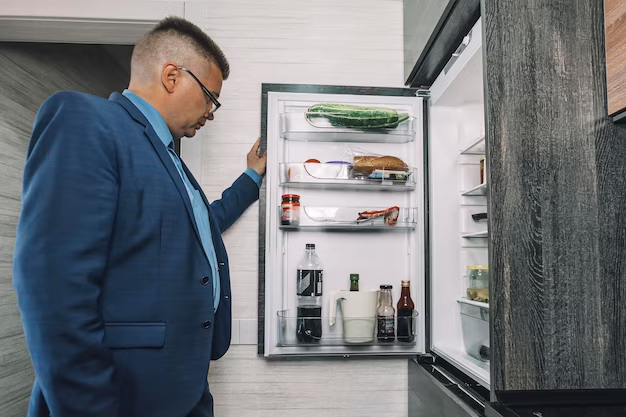Mastering the Art of Defrosting Your Small Refrigerator: Tips and Insights
Imagine this: you're preparing to enjoy a refreshing evening drink or grab a midnight snack, but as you reach into your small refrigerator, you're greeted with thick frost that has slowly encroached upon your chilled haven. If this scene rings a bell, you're not alone. Frost build-up is a common challenge faced by many, especially in smaller refrigerators. But don't worry—defrosting doesn't have to be a daunting task. In this guide, we'll walk you through the process, share practical tips, and explain how to prevent frost from hampering your refrigeration delight.
🌨️ Why and When to Defrost: Understanding Frost Build-up
The Science Behind Frost: Frost forms when warm, humid air enters the refrigerator, comes into contact with its cold surfaces, and then condenses and freezes. This is a typical occurrence in the life of a refrigerator, especially when it's frequently opened in humid environments.
Signs It’s Time to Act:
- Reduced Storage Space: A noticeable layer of frost can significantly reduce the available space, making it difficult to store items efficiently.
- Decreased Efficiency: Frost also makes your fridge work harder, increasing energy consumption and potentially shortening its lifespan.
- Door Won't Close Properly: Thick frost can prevent the door from sealing correctly, letting warm air in, and exacerbating the problem.
When defrosting becomes necessary, taking proactive steps can help maintain the appliance's performance and efficiency.
🧊 Essential Preparation for Defrosting
Before diving into the defrosting process, consider the following preparatory steps to ensure a smooth experience:
1. Emptying the Contents:
- Long Shelf-Life Items: If possible, plan to defrost when your fridge is relatively empty. Transfer perishables to a cooler with ice packs.
- Perishable Items: Ensure you have a plan for perishable goods—placing them in a neighbor’s fridge temporarily can be a solution.
2. Gathering Supplies:
- Absorbent Towels: Handy for soaking up melting ice and water.
- Bowl or Basin: To catch excess water from the bottom of the fridge.
- Mild Cleaning Solution: Warm water and mild detergent for cleaning surfaces after defrosting.
3. Disconnecting Power:
Ensure that you unplug the refrigerator to safely defrost it and prevent short circuits or electrical hazards.
❄️ Step-by-Step Guide to Defrosting Your Small Refrigerator
Step 1: Unplug the Unit
Begin by unplugging the refrigerator. This ensures safety and allows the appliance to start warming up.
Step 2: Remove Shelves and Drawers
Take out any removable shelves and drawers. Set them aside for cleaning and drying.
Step 3: Address the Ice Build-Up
- Natural Thaw Method: Simply leave the freezer door open to allow warm air to circulate, melting the frost naturally. Be patient—this can take several hours.
- Speed Up with Warm Water Bowls: To expedite the process, place bowls of hot water inside the fridge. The steam will help melt the ice quicker.
- Avoid Sharp Tools: Never use knives or sharp objects to chip away ice, as this could damage the interior and create leaks.
Step 4: Clean the Interior
Once the frost is melted, wipe down the interior with a solution of warm water and mild detergent. Dry thoroughly to prevent future frost build-up.
Step 5: Organize and Refill
After cleaning, reposition the shelves and drawers. Plug the refrigerator back in and return food when it reaches optimal temperature.
🚫 How to Prevent Future Frost Build-Up
Preventing frost from accumulating again can save you time and effort in the future. Here are a few tips:
- Door Seals Check: Ensure that the doors seal tightly. Loose seals can let moisture in, leading to frost.
- Mindful Usage: Keep the door closed as much as possible to prevent warm air from entering.
- Organize Inside: Keep food items organized for quick access, minimizing time the door is open.
- Temperature Settings: Adjust settings seasonally, keeping in mind that a too-cold setting may contribute to frost build-up.
📌 Key Takeaways for Keeping Your Fridge Frost-Free
By maintaining awareness and practicing regular upkeep, your small refrigerator can remain an asset in your kitchen, delivering optimal food storage without the unwanted icy surprises.
📊 Quick Reference Table: Defrosting Your Small Refrigerator Efficiently
| Step | Description | Pro Tip |
|---|---|---|
| 🛑 Unplug & Empty | Safely disconnect power and clear contents. | Use a cooler to slight perishables |
| 🧼 Remove & Clean | Take out and wash shelves and drawers. | Warm detergent solution works best |
| 💦 Melt the Ice | Use warm air or bowls of hot water. | Avoid sharp tools to remove ice |
| 🧴 Sanitize & Dry | Wipe down interior and dry thoroughly. | Ensure all water is removed |
| 🔌 Restore Power | Plug the refrigerator back in and monitor temperature. | Wait until optimal chill is resumed |
In the end, ensuring your small refrigerator operates smoothly is a commitment to both efficiency and convenience. Regularly managing frost not only maintains storage space but enhances the lifespan and performance of your appliance. By embracing these tips and techniques, you're well-equipped to keep frost at bay, making your cooling experience more seamless and satisfying.
